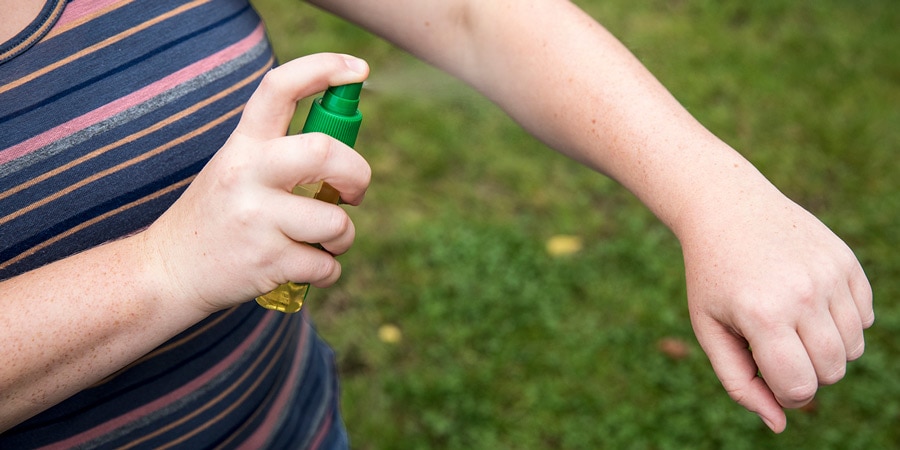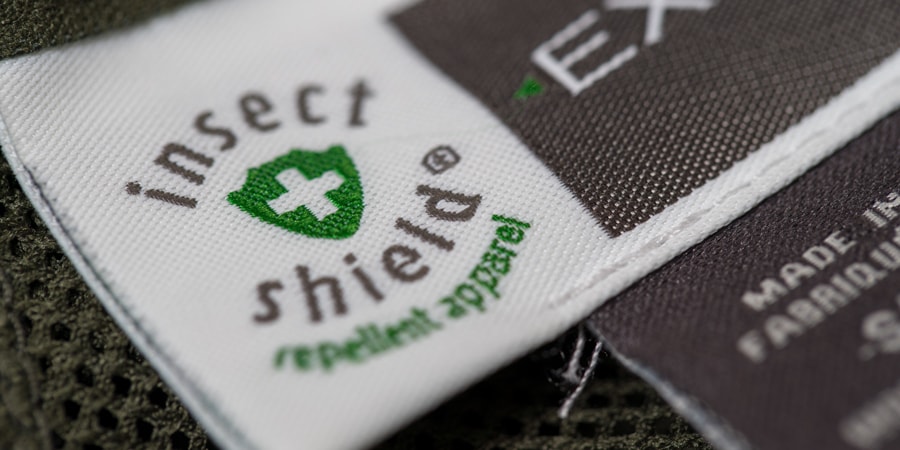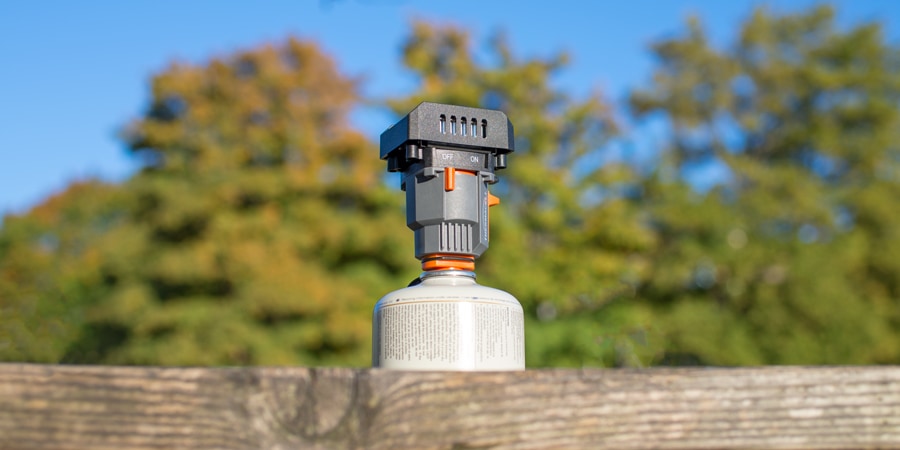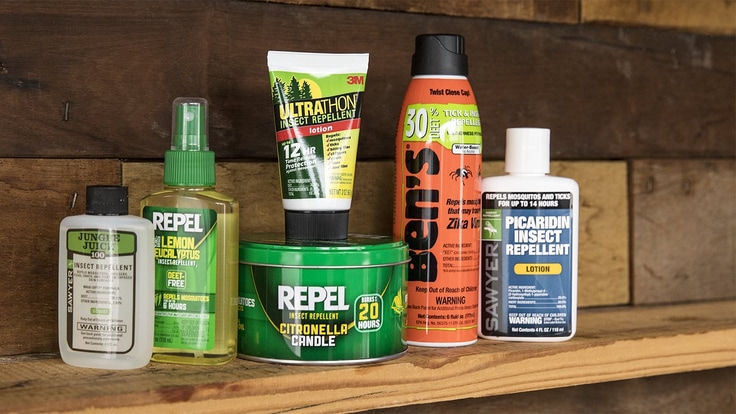Encountering wildlife outdoors can be a profound experience. Encounters with buzzy, creepy crawly creatures, though, move us in other ways: to swat, to mutter, to slather. And, as the number of diseases and the range of pests that transmit them grow, choosing and using insect repellents wisely is more important than ever.
That said, it can be confusing figuring out which methods are most effective at repelling insects while minimizing our own exposure to chemicals we might want to avoid. In this article, we break down the various options for you.
Your main choices when selecting an insect repellent are the following:
- Insect repellent you apply to skin: These are your most effective options, but you have to apply these products carefully and repeatedly.
- Insect repellent applied to clothing: You're ready to go as soon as you're dressed and it provides protection for the widest range of bugs. However, insect-repellent clothing only offers limited protection for exposed skin, so combining clothing- and skin-based repellents is the way to give yourself comprehensive coverage.
- Airborne insect repellent: No application is required and it keeps mosquitoes at a distance; it won't work on other pests, though, or when conditions are windy or you're on the move.
It's also worth noting that different repellents work on different bugs. Mosquitoes are the one pest all repellents are designed for, and many repellents are effective against ticks as well. Black flies and no-see-ums (aka midges, sandflies and biting gnats) aren't a big disease risk, but are pests nonetheless. Repellents offer varying levels of protection against flies (many offer none at all). And finally, no repellent works against stinging insects. If you're dealing with yellow jackets at home, then trap-style products will be your best option.
Note, too, that not all pests mentioned here fall within the insecta class (ticks are in the arachnida class, for example). For simplicity's sake, though, we'll be using the term "insect" in its popular sense ("any potential disease-carrying bug") throughout this article.
Types of Insect Repellents for Skin

Insect repellents you apply to skin include chemicals such as DEET and picaridin, as well as natural or synthetic plant oils. Overall, chemical repellents like DEET and picaridin offer long-lasting and wide-ranging protection, repelling mosquitoes, ticks and many fly species. Synthesized plant oils, like lemon eucalyptus oil and IR3535, don't protect quite as long and are effective against mosquitoes and some tick species. Plant-based repellents appeal to those who prefer more natural formulations, but their performance significantly lags in levels of protection, length of protection and how many bugs they repel.
All chemical-based repellents are certified as OK for use as directed by the EPA. It's important to follow use directions carefully, though, especially when kids or pets are involved. Age guidelines vary so read instructions carefully—at a minimum, most repellents will advise that you avoid use on children younger than 6 months old.
Here are the main types of insect repellents for your skin:
DEET (mosquitoes, ticks, some flies): Developed by the U.S. Army in the 1940s, it's the world's most widely used repellent. While it has been studied and used extensively for decades, DEET can damage plastic and synthetic gear components, so wash hands thoroughly after use and be careful about it coming into contact with your gear.
Concentrations of DEET range from 10 percent (for about two hours of protection) to 100 percent (up to 10 hours). Maximum protection is achieved at 30% DEET formulations—higher concentration levels simply make your protection last longer. Controlled-release formulas, though, which include just 20 to 30 percent DEET, provide protection for up to 12 hours. That makes controlled-release DEET an excellent option for people seeking to minimize DEET concentration levels on themselves or their children. As a bonus, controlled-release DEET also minimizes the DEET's effect on plastics and synthetics.
You find varying recommendations regarding DEET and some people are leery about using it. That said, DEET has been more widely studied than any other repellent and the EPA reports that using DEET as instructed does not present a health concern to the general population, including children. The Environmental Working Group (EWG) insect repellent guide also reports that DEET is safer than many people assume and is highly effective for areas with disease-carrying pests. If you do use a DEET repellent, then you should faithfully follow the application guidelines provided with the product, especially when applying it on children.
Picaridin (mosquitoes, ticks, flies): Effective against the greatest range of insects, this chemical is a synthetic version of a repellent found in pepper plants. Maximum protection is provided in formulations with 20 percent picaridin. Spray versions protect for up to 12 hours against mosquitoes and ticks, and up to eight hours against flies; lotion formulations last for up to 14 hours against mosquitoes and ticks, and up to eight hours against flies.
Picaridin vs. DEET
Because they're the most effective repellents, people often ask which is better. Here's a quick comparison:
- DEET: It's considered the gold standard in terms of its effectiveness. It's been used and studied more than any other repellent in human history, though it must be handled carefully because it can damage plastics (think sunglasses, trekking pole grips, etc.)
- Picaridin: Though it's been around for fewer decades, its efficacy is considered comparable to DEET for mosquitoes and ticks, and it works better on flies. Picaridin also has minimal odor and no damaging effect on plastics and other synthetics.
Shop DEET-Based Insect Repellents
Shop Picaridin Insect Repellents
Synthesized Plant Oils (mosquitoes, some ticks): These synthesized plant oils are still considered chemicals and are regulated by the EPA for use on humans.
- Lemon eucalyptus oil can repel mosquitoes for up to six hours.
- IR3535, a synthetic based on a natural amino acid, can last up to eight hours
Natural (Nonsynthesized) Plant Oils (mosquitoes): Natural
oils (soybean, lemongrass, citronella, cedar, peppermint, lavender, geranium or geraniol, et al.) aren't regulated for safety or effectiveness by the EPA. Generally, they're considered less effective and they have to be reapplied far more frequently than chemical alternatives.
"Wearable" Insect Repellents (mosquitoes): Some natural products are integrated into wristbands or clips you can hang on clothes or gear. They rely on nonsynthesized plant oils to repel mosquitoes. Though this is more convenient than the skin-applied oils, it will leave areas of your body far away from the wearable vulnerable to bites.
Insect-Repellent Clothing

Permethrin (mosquitoes, ticks): Mosquito- and tick-repellent clothing uses this synthetic chemical that acts like a natural extract from chrysanthemums and kills insects that come into contact with it. You can buy clothing that's been pretreated with it or you can spray it onto clothing to stop mosquitoes from biting through and ticks from crawling across. Note that, regardless of whether you buy pretreated clothing or spray permethrin on your clothes, you'll need to wash insect-repellent clothing separately from your other laundry.
This method offers always-on protection and you can go on multiple trips before re-treating your clothing. However, repellents applied to clothing are not effective against flies and skin-applied products are still needed for total protection.
There are two ways to shop for clothing-based repellents:
- Pretreated insect-repellent clothing: Buying clothing that manufacturers have infused with permethrin is more convenient than treating your own clothing with spray-on products. And pretreated clothing retains effectiveness roughly 10 times as long (up to 70 washings).
Shop Insect-Repellent Clothing
DIY insect-repellent for clothing: The advantage to treating your own clothing is that you can wear your favorite items on the trail. You can also apply spray-on permethrin to items like tents, packs, hammocks or even bug netting for added protection. You can even apply it to dogs, though that requires carefully following these guidelines. Never allow spray-on products to wash directly down the drain or into any water source because they are harmful to aquatic life—if you need to dispose of old permethrin, take it to your local hazardous waste facility.
Shop Insect Repellent for Clothing
Airborne Insect Repellents

When you're staying in one general area, such as hanging around your campsite, you can use special dispersal devices to release a chemical that creates a zone of mosquito-free airspace. Protection lasts as long as the device is fueled up and turned on. This is nice because there's no messing with skin application and mosquitoes are kept far away. That said, this method works only on mosquitoes and won't work if you're moving or out in windy conditions.
Allethrin (mosquitoes): Devices that disperse allethrin, a synthetic derivative of chrysanthemum plants, use a small amount of butane fuel or a rechargeable lithium battery and allethrin repellent mats. They create a "zone of protection" for as long as the device is running.
Citronella (mosquitoes): Note that citronella candles, which would technically be considered "airborne" options, are far less effective. That's due to the repelling agent's performance and the fact that a candle isn't calibrated to widely and uniformly disperse the repellent.
Insect Repellent Comparison Chart
Active Ingredient | Type | Insects Affected | Duration* |
|---|---|---|---|
| Skin Repellents | |||
| DEET | Chemical | Mosquitoes, ticks, some flies | Up to 12 hours |
Picaridin | Synthesized pepper plant ingredient | Mosquitoes, ticks, flies | Up to 14 hours |
Oil of lemon eucalyptus | Synthesized plant oil | Mosquitoes | Up to 6 hours |
IR3535 | Synthesized plant oil | Mosquitoes | 4-8 hours |
Plant oils (soybean, lemongrass, cedar, citronella, etc.) | Natural plant oil | Some mosquitoes | Estimated 30 min. to 2 hours |
Clothing Repellents | |||
Permethrin | Synthesized chrysanthemum plant ingredient | Mosquitoes, ticks | Up to 70 washings in pretreated clothing; up to 6 washings when sprayed on; alternatively, it loses effectiveness after 6 or more weeks of outdoor exposure |
"Wearable" plant oils (integrated into wristbands or clip-on products) | Natural plant oil | Some mosquitoes (in the vicinity of the wearable item) | Multiple days |
Airborne Repellents | |||
Allethrin | Synthesized chrysanthemum plant ingredient | Mosquitoes | As long as emission device is running (repeller refills lasts 4 hours) |
Citronella candle | Natural plant oil | Some mosquitoes | As long as the candle burns |
*Note: Our chart of active ingredients lists duration times if you follow the application instructions faithfully and use the longest-lasting formulation of that ingredient.

